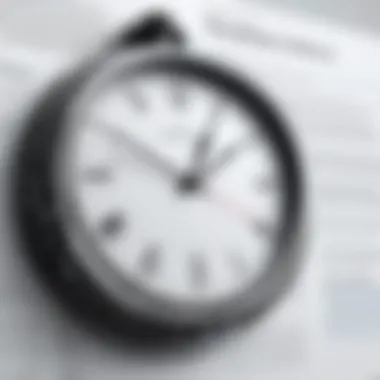Understanding Timeslips: Insights and Applications


Intro
The study of timeslips is an intriguing subject that straddles various domains, including psychology, technology, and literature. It not only challenges our conventional understanding of time but also opens avenues for exploration in human experience. Many describe timeslips as moments where individuals perceive a distortion in time, creating a connection to past or future events. By unpacking this complex phenomenon, we can gain valuable insights into our perception of reality and its implications in numerous contexts.
The relevance of this topic is profound. In our fast-paced world, the nature of time becomes even more central to various disciplines. Whether discussing technological applications that measure or manipulate time digitally, or delving into psychological implications where timeslips affect mental health and cognition, the discourse is both essential and enriching. Furthermore, literature often captures these themes through narrative mechanisms, illustrating human encounters with time’s fluidity.
This article aims to dissect the underlying theories of timeslips, explore case studies of notable instances, and illuminate the cultural significance of the phenomenon. Throughout this exploration, readers will not only confront the implications of timeslips but also examine how these insights manifest in contemporary society, providing a rounded perspective on a topic that is often marginalized.
Definition of Timeslips
To fully grasp the concept of timeslips, it is crucial to understand its definition. Timeslips refer to phenomena where individuals experience a distortion in the perception of time. This could manifest as an abrupt transition into a different temporal context, seemingly escaping the present moment. The implications of studying timeslips extend beyond mere curiosity; they open discussions about the nature of consciousness, memory, and reality. In various contexts, such as psychology and cultural studies, timeslips challenge our conventional understanding of time.
By dissecting this definition, we can see several key elements that stand out:
- Perception Versus Reality: Timeslips emphasize the gap between subjective experienced time and objective, measured time.
- Cultural Impact: Many cultures have narratives or myths centered on time travel or altered states of time, bringing an anthropological perspective to the study of timeslips.
- Practical Considerations: For researchers and professionals, understanding timeslips can influence fields like user experience design in tech by better accommodating human cognitive limitations regarding time perception.
Historical Context
Historically, the idea of timeslips is not new. Ancient civilizations often contemplated time as cyclical rather than linear. Texts from cultures around the world reflect a fascination with altered time experiences. For example, in Hindu philosophy, the concept of Kalachakra speaks of time cycles and their spiritual significance.
The modern interpretation began taking shape in the 19th century with the rise of scientific thought. As psychology emerged as a field, early thinkers such as Sigmund Freud considered how subconscious processes might warp temporal perception. Fast forward to the present, and researchers from cognitive science and neuropsychology are investigating these experiences with increasing rigor.
Scientific Perspective
From a scientific standpoint, timeslips present a unique challenge. Research indicates that how we perceive time can be influenced by various factors, including emotional states and cognitive load. Neuroscientists have identified specific brain regions involved in temporality, such as the anterior insula and the right parietal lobe. Understanding these neural circuits is critical for decoding why individuals experience timeslips.
Several experiments and studies also highlight the role of attention. Moments of intense focus may lead to perceived time dilation, suggesting that timeslips could be an adaptive cognitive response.
A few significant areas of interest include:
- Temporal Illusions: Studies exploring how illusionary experiences, like the “stretched” feeling of time in high-stress situations, relate to timeslips.
- Neuropsychological Disorders: Some conditions, such as epilepsy, have been linked to altered temporal perception, revealing potential physiological mechanisms behind timeslip experiences.
In summary, the definition of timeslips is foundational to understanding their broader implications. By examining both the historical context and scientific perspective, we come to appreciate the complexities involved in studying time perception. This sets the stage for further exploration of theories and applications related to timeslips.
Theories Explaining Timeslips
Exploring theories that explain timeslips is essential in comprehending the complexities of this phenomenon. Understanding these theories not only sheds light on the mechanisms behind timeslips but also opens discussions on how our perception of time can be altered. Each theory provides unique insights which can be applicable across different disciplines including psychology, physics, and cultural studies.
Psychological Theories
Psychological theories provide a framework for analyzing the subjective experiences of individuals who report timeslips. The state of the mind plays a critical role in how time is perceived. Cognitive psychology suggests that our memory and attention are crucial in forming our understanding of time. Stress, fatigue, and certain mental states can distort an individual's sense of time, leading to the sensation of experiencing different temporal realities.
For example, during highly emotional events or moments of deep concentration, people report feeling as though time has either slowed down or sped up. This theory aligns with findings from studies in neuropsychology, which examine how different parts of the brain process time. It shows that our internal clock is not always accurate and can easily be disrupted by various psychological factors. In addition, altered states of consciousness often seen in dreams or meditative states often lead to descriptions of timeslip-like experiences.
"The mind's perception of time is not a constant; it is highly influenced by emotional and psychological states."
Physical Theories


Physical theories focus on the scientific understanding of time. They consider how timeslips might be explained through the lens of physics or quantum mechanics. One prominent concept is the theory of relativity put forth by Albert Einstein. This theory posits that time is not absolute but can vary for different observers depending on their speed and proximity to massive bodies.
Further, discussions around multi-dimensional theories suggest that time may not be linear, as commonly perceived. Instead, some physicists speculate about the existence of parallel universes or alternate realities, where different timelines occur simultaneously. This notion raises questions about the nature of reality and how individuals might inadvertently experience different times or locations within a multidimensional framework.
Cognitive Aspects of Timeslips
The cognitive aspects of timeslips are crucial in understanding how individuals perceive time and reality. These phenomena challenge our traditional notions of how time is experienced. By dissecting the ties between cognition and temporal experiences, we can gain insights into human psychology and the complexities of consciousness. This section delves into two main areas: perception of time and memory relating to timeslips.
Perception of Time
Perception of time is a fundamental experiential element that shapes our daily lives. It relies not only on objective measures but also on subjective mental processes. Timeslips can alter this perception dramatically, creating a distortion where past, present, and future intertwine. People may report sudden feelings of dislocation or a sense of being in another era altogether.
Research shows that various factors influence how we recognize the passage of time, including attention and emotional states. When someone experiences a timeslip, attention is often directed inward, leading to an overwhelming sensation that influences their temporal framework. This distortion can further enhance or diminish memories, leading to unique experiences for each individual.
Memory and Timeslips
Memory is another cognitive facet closely tied to timeslips. When timeslips occur, they can affect how memories are constructed and recalled. This peculiarity often leads to what some may describe as vivid or fragmented memories. Events that may have been mundane could suddenly regain significance amid a timeslip experience.
Moreover, timeslips may reveal potential discrepancies in memory reliability. The phenomenon illuminates how memories can be reshaped, lost, or embellished over time. Various theories exist regarding how the brain processes these alterations, allowing for multiple interpretations of an event. This aspect is particularly fascinating to cognitive psychologists and neuroscientists studying memory structures.
Understanding how timeslips impact perception and memory offers rich insights into human cognition.
In summary, the cognitive aspects of timeslips provide a lens into the intricate workings of the mind. They reveal the fluidity of time perception and memory, challenging the rigid frameworks often accepted in cognitive science. As we continue to explore these themes, we may uncover deeper understandings relevant to psychology and everyday human experiences.
Cultural Representations of Timeslips
Cultural representations of timeslips play a crucial role in understanding the phenomenon itself. They provide a rich tapestry of interpretations that vary across different societies and artistic mediums. By analyzing how timeslips are depicted, we can uncover collective attitudes toward the concept of time and reality. These representations influence not only artistic expression but also shape public perception and academic discourse.
Literature and Timeslips
Literature has long served as a platform for exploring the complexities of time. Novels often depict timeslips to challenge the linear perception of time, allowing characters to navigate between different eras. Works like Henry James' "The Turn of the Screw" or more contemporary titles like Audrey Niffenegger's "The Time Traveler's Wife" utilize timeslips. These narratives invite readers to reflect on the nature of memory, loss, and the human experience.
Through these stories, literature becomes a vehicle for philosophical exploration. It can raise questions about causality, destiny, and the implications of revisiting the past. As a result, literary timeslips not only entertain but also provoke deep thought about how individuals relate to their personal histories.
Film and Media
Film and media provide another lens through which timeslips can shine. Iconic films such as "Back to the Future" or "Inception" utilize visual storytelling to present timeslips in compelling ways. These cinematic approaches engage viewers by blending science fiction with human emotion and ethical dilemmas. The combination creates an immersive experience that makes the concept of timeslips accessible to a broad audience.
Media representations often reflect societal concerns about technology and progress. For instance, films that depict timeslips may comment on modern life's accelerating pace, raising questions about the consequences of technological advancement on human experience. Through these portrayals, filmmakers facilitate dialogues around time's malleability and the profound implications of seeking control over it.
Artistic Interpretations
Art in its various forms—painting, sculpture, and installation—also reflects interpretations of timeslips. Artists often explore themes of time through fragmented spaces or illusions. For example, Salvador Dalí's surreal works manipulate time visually, creating dreamlike scenarios where the flow of time becomes fluid. These artistic interpretations go beyond mere representation; they challenge the viewer’s perceptions of reality and encourage introspection.
Moreover, contemporary installations such as those by artist Yayoi Kusama often engage with repetitive patterns and the passage of time. Through these immersive experiences, audiences are prompted to reflect on their perception of time and existence. Artistic representations of timeslips serve both to illustrate and to interrogate the complexities surrounding our understanding of time.
"Art enables us to find ourselves and lose ourselves at the same time." – Thomas Merton
Case Studies of Timeslips


Case studies of timeslips provide a unique lens to analyze this phenomenon, blending empirical observation with subjective experience. They illuminate the nuances of timeslips, presenting both historical contexts and modern interpretations. By examining specific incidents, we gain insights into how timeslips manifest in varied environments, reflecting cultural beliefs and psychological factors. The value in studying these case studies lies in the way they help clarify theories related to time perception, memory, and reality. Moreover, they can contribute significantly to various fields, including psychology, literature, and even technology.
Famous Instances
Famous instances of timeslips are often rich in narrative and complexity. One notable case is the account of two women in Aberdeenshire, Scotland, who reportedly experienced a brief journey to the year 1734. During their experience, they claimed to observe a village scene with people dressed in period-appropriate clothing. This incident is frequently cited as it prompts critical discussion on the nature of time and perception. The intensity and clarity of their memories make this case particularly compelling.
In another case, a soldier during World War II experienced a timeslip while on patrol. He found himself in a tranquil landscape that resembled the home he had left behind, despite being in the midst of combat. His recollection of this moment provides a fascinating intersection between stress, memory, and perceived reality. Such cases are valuable not just for historical interest; they also invite analysis regarding the psychological aspects of stress, trauma, and how they can affect our understanding of time.
Recent Reports
Recent reports of timeslip experiences continue to emerge, reflecting ongoing intrigue in this field. One example involves individuals who have reported time losses during periods of intense focus or meditation. Participants often describe moments where time seems to either speed up or stretch interminably, hinting at a flexible relationship between awareness and temporal progression.
Furthermore, there has been an increase in documented reports among those using virtual reality technology. Users sometimes report sensations of dislocation in their perception of time while immersed in virtual worlds. This interaction raises essential questions about the implications of digital environments on human cognition and our understanding of time. Such reports are essential for researchers as they explore this contemporary landscape and its broader implications for society.
Case studies serve as critical touchpoints, connecting theory with practice and revealing the multifaceted nature of timeslips.
By integrating these case studies into broader discussions, a clearer picture of the complex interplay between time, perception, and reality emerges. It encourages further inquiry into how these phenomena challenge our understanding of time itself.
Implications of Timeslips
The implications of timeslips extend beyond mere curiosity and touch on significant elements in various fields, particularly in philosophy and ethics. Understanding these implications fosters a broader perception of how time is experienced and interpreted. This understanding not only enriches academic discourse but also influences real-world applications involving technology, psychology, and culture.
Philosophical Considerations
Timeslips challenge our conventional understanding of time. They prompt us to ask profound questions about consciousness and reality. Are timeslips a mere figment of our imagination? Or do they suggest an underlying system of time that is non-linear? The debate is ongoing.
Philosophers have often pondered the nature of time — is it absolute, as Newton suggested, or relational, as Einstein derived? Timeslips add complexity to this discussion. They imply that individual experience of time is subjective. Personal accounts of timeslips reveal a spectrum of experiences that often resist classification within standard temporal frameworks. Understanding this could aid in developing theories about perception, consciousness, and even the multiverse.
*Consider:
- How do experiences of timeslips inform our understanding of reality?
- What does it mean for our perception if time can be fluid?*
"The most beautiful thing we can experience is the mysterious. It is the source of all true art and science."
— Albert Einstein
This raises further philosophical inquiries. For instance, how do timeslips affect our concepts of existence and being? The experience of slipping through time could suggest that our reality is more complex than it appears. This complexity might influence theories in metaphysics, pushing for more nuanced understandings of existence beyond the tangible world.
Ethical Dimensions
The ethical implications of timeslips are equally compelling. If an individual can experience events or realities outside their temporal continuity, this could lead to moral dilemmas. For example, consider the implications of observing past tragedies or potential futures. Should individuals intervene in events they witness, even if just as observers? This brings forth questions related to free will, responsibility, and the consequences of action versus inaction.
Furthermore, integrating timeslip phenomena into technology may also raise ethical concerns. For instance, if we could manipulate or replicate timeslip experiences within virtual environments, what implications would this have on mental health or societal norms? Would creating such experiences be deemed responsible, considering potential psychological impacts?
Key considerations include:
- Ensuring that timeslip experiences recognize the emotional weight they carry.
- Debating whether ethical guidelines should govern technologies that attempt to simulate or replicate timed experiences.
Challenges in Studying Timeslips


Studying timeslips presents unique challenges that researchers must navigate carefully. The intricate nature of time perception complicates the collection of empirical data on this phenomenon. Some studies indicate that timeslips may rely heavily on subjective experiences, making it difficult to establish universally applicable methodologies. Insights into this topic are essential not only for academic discourse but also for practical applications in fields such as psychology and technology.
Methodological Issues
Methodological challenges arise primarily due to the subjective nature of timeslips. Capturing a timeslip experience often depends on personal narratives, which can vary significantly across individuals. This variability complicates the establishment of controlled environments necessary for scientific rigor.
- Qualitative Data: Much of the evidence comes from personal testimonies or anecdotal accounts, which lack standardized measures. As a result, it can be challenging to quantify experiences reliably.
- Lack of Reproducibility: Traditional experimental designs may not effectively replicate the conditions leading to a timeslip experience. Researchers might find it difficult to recreate specific environmental stimuli that could invoke such experiences, leading to inconsistent results across studies.
- Shortage of Longitudinal Studies: There is a need for more longitudinal research to understand how timeslips manifest over an extended period. Most studies tend to focus on immediate experiences, missing out on long-term implications.
Interdisciplinary Approaches
Addressing the challenges of studying timeslips necessitates an interdisciplinary approach. By integrating perspectives from various fields, researchers can better analyze the complexities surrounding this phenomenon.
- Psychology: Psychological analysis can provide insights into how individuals perceive and process time. Understanding cognitive biases and memory distortion is essential for interpreting timeslip experiences.
- Physics: Theoretical physics can inform the broader implications of time, particularly in understanding how different frameworks could interpret timeslips. Concepts such as relativity can challenge our conventional understanding of time.
- Cultural Studies: Exploring how different cultures interpret timeslips can illuminate their significance. Cultural narratives often influence individual experiences, making it crucial to contextualize timeslips within varying social frameworks.
As researchers continue to explore this intriguing area, forging stronger links between disciplines will enhance our comprehensive understanding of timeslips, offering a richer narrative into both their implications and applications.
Future Directions for Research
Research on timeslips presents a multidisciplinary field, containing many insights yet to be explored. The study of timeslips can significantly contribute to not only psychological understanding but also various applied domains such as technology and arts. By focusing on future directions in this field, researchers can enhance our grasp of these phenomena and their implications.
Emerging Technologies
Technological advancements are critical for the study of timeslips. The integration of virtual and augmented reality, for instance, can offer immersive experiences that further our comprehension of time perception. Tools like EEG and fMRI can provide valuable data on the brain's activity during timeslip experiences, allowing researchers to analyze emotional and cognitive responses.
To this end, the development of new software applications can enable individuals to document their timeslip experiences in real-time. This can lead to a richer database for analysis, contributing to more thorough longitudinal studies. Such technologies hold the potential to solidify a scientific framework for understanding how timeslips occur intermixed with current reality.
Additionally, machine learning algorithms can be used to recognize patterns in experiences reported across diverse populations. This data can contribute to a more nuanced comprehension of the factors that trigger timeslips.
Expanding the Scope
Expanding the scope of research on timeslips requires interdisciplinary collaboration. For example, involving experts from fields such as neuroscience, psychology, and cultural studies can lead to a more rounded analysis. This allows the synthesis of various insights that can cater to a broader audience. The implications of timeslips can be explored in different contexts, such as their influence in virtual environments or their representation in art and literature.
Moreover, researchers could benefit from engaging the public through community studies. These efforts can shed light on personal narratives and enrich the academic discourse about experiences that may not fit neatly into existing paradigms.
The End
The conclusion serves a vital role in encapsulating the discussions presented throughout this article, emphasizing the significance of understanding timeslips in various contexts. It is not merely a summary; it reflects on the deeper implications derived from the exploration of this phenomenon. By distilling key insights, the conclusion reinforces the importance of timeslips to the larger fields of psychology, technology, and culture.
This section underscores the necessity for ongoing investigation into timeslips, extending beyond surface observations. Recognizing the breadth of applications—from enhancing psychological theories to providing insights into technological advancements—affirms timeslips as a compelling subject worthy of academic and practical scrutiny. Additionally, it highlights the ethical and philosophical considerations that should accompany any inquiry into human experience and perception of time.
Summary of Key Insights
In this article, several key insights have emerged regarding timeslips. These insights are critical for establishing a well-rounded understanding of the implications and applications of this concept:
- Cultural Relevance: Timeslips are not confined to a niche subject. Their representations in literature, film, and art have captured public imagination and shaped cultural narratives.
- Psychological Dimensions: Understanding timeslips requires engaging with psychological theories that explain alterations in time perception, memories, and subjective experiences.
- Interdisciplinary Collaboration: Challenges in studying timeslips are best addressed through collaborative efforts across various fields, including psychology, philosophy, and technology, promoting shared knowledge and methodological innovation.
- Future Research Directions: The adoption of emerging technologies may yield new findings and enhance our comprehension of timeslips, inviting further exploration into previously under-researched territories.
Final Thoughts on Timeslips
The journey through the realm of timeslips underscores a complex interplay between human experience and the constructs of time. As researchers and scholars continue to decipher these occurrences, it becomes increasingly apparent that timeslips challenge our conventional understanding of reality. These phenomena invite us to reconsider time not merely as a linear progression but as an intricate tapestry woven with the threads of memory, perception, and cultural stories.
Continued exploration into timeslips promises to yield deeper insights about the nature of existence and consciousness. As technology advances, new methodologies will undoubtedly enrich our understanding and open doors to further discussions. Thus, timeslips represent both a scholarly imperative and a cultural curiosity, warranting sustained interest and inquiry in our ever-evolving exploration of reality.
"Understanding timeslips is not just about tracking irregularities in time but about exploring the profound implications these experiences hold for our understanding of consciousness and reality."
In sum, the examination of timeslips stimulates exciting dialogue among academics, practitioners, and the curious public, ensuring its place as a pertinent topic in ongoing discussions.







